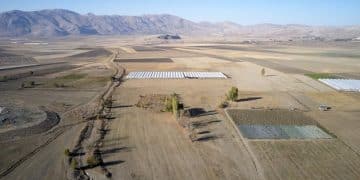Smart grid efficiency analysis: unlocking energy potential

Smart grid efficiency analysis enhances energy management by integrating AI, renewable sources, and blockchain technology, leading to cost savings, improved reliability, and consumer empowerment in energy usage.
Smart grid efficiency analysis is becoming essential in today’s energy landscape. Have you thought about how this approach can reshape your energy consumption? Let’s dive in and explore its potential benefits and applications.
Understanding smart grid technology
Understanding smart grid technology is crucial in today’s rapidly evolving energy landscape. By integrating advanced communication and control systems, smart grids enhance the efficiency and reliability of electricity distribution.
Key Components of Smart Grids
A smart grid consists of several key elements that work together to optimize energy usage. These components include:
- Smart Meters: Allow for real-time monitoring of energy consumption.
- Automated Control Systems: Improve the efficiency of energy distribution.
- Advanced Sensors: Detect outages and monitor grid health.
- Renewable Energy Integration: Facilitate the use of sustainable energy sources.
By using smart meters, consumers can track their energy use in real time. This information empowers them to make informed decisions about their energy consumption. Furthermore, automated control systems play a pivotal role in maintaining grid stability, especially during peak demand periods.
Smart grids also leverage renewable energy sources like solar and wind. This integration reduces reliance on fossil fuels and promotes a cleaner environment. As more renewable sources are added to the grid, the ability to manage and distribute energy efficiently becomes increasingly important.
Benefits of Smart Grid Technology
There are numerous benefits associated with smart grid technology.
- Enhanced reliability and fewer outages.
- Increased energy efficiency.
- Lower operational costs for utility companies.
- Empowered consumers through better energy management.
These advantages not only save money for both consumers and utilities but also support a more sustainable energy future. By investing in smart grid technology, communities can build stronger, more resilient energy systems.
Benefits of enhancing grid efficiency

Enhancing grid efficiency brings numerous benefits that positively impact both consumers and utility companies. These advantages range from cost savings to increased reliability, making smart grid technology a vital component of modern energy systems.
Cost Savings for Consumers and Utilities
By improving the efficiency of energy distribution, both consumers and utility companies can see significant cost reductions. Lower energy bills result from optimized energy usage, while utilities can reduce operational costs related to energy waste.
- Reduced energy waste: Enhanced efficiency lowers the amount of energy lost during transmission.
- Lower operational costs: Utilities spend less on maintenance and management.
- Incentives for consumers: Many organizations offer programs that reward reduced energy consumption.
These savings benefit not just the wallet but also the environment, as lower energy demand can lead to reduced emissions.
Increased Reliability
Another advantage of enhancing grid efficiency is increased reliability. A more efficient grid is better equipped to handle fluctuations in energy demand. This ensures that power outages are less frequent and shorter in duration. Smart systems can detect issues and respond quickly to prevent possible disruptions.
This reliability allows consumers to enjoy uninterrupted access to energy, making everyday activities smoother. Imagine a scenario where power outages are almost eliminated; households and businesses can operate efficiently without worry.
Empowerment of Consumers
Enhanced grid efficiency also empowers consumers by providing them with real-time data concerning their energy usage. With the help of smart meters, individuals can track their consumption habits and adjust accordingly. This leads to smarter energy choices and can foster a sense of responsibility toward sustainable practices.
- Understanding usage patterns helps consumers save more.
- Awareness fosters the adoption of renewable energy sources.
- Encourages involvement in community energy initiatives.
Being informed means consumers can actively participate in reducing energy usage. This not only benefits them financially but also contributes to a larger movement towards a more sustainable future.
Key metrics for efficiency analysis
When conducting a smart grid efficiency analysis, it’s essential to focus on key metrics that accurately reflect the effectiveness of the system. These metrics help utilities and consumers understand how energy is being used and how improvements can be made.
Energy Loss Metrics
Energy loss is a critical factor in determining grid efficiency. It refers to the electricity that is not delivered to consumers but is wasted during transmission. Monitoring these losses can highlight areas needing improvement.
- Transmission Loss: The energy lost as electricity travels through power lines.
- Distribution Loss: The energy lost between substations and end-users.
- System Overall Efficiency: Calculated by comparing total generation to total demand.
By measuring these losses, utilities can identify weak spots in their infrastructure and implement solutions to reduce waste.
Load Management Metrics
Understanding how the load is managed on the grid is also vital. Load management metrics inform utilities about demand patterns and help them prepare for peaks in energy use. This allows them to optimize energy distribution effectively.
- Peak Load: The maximum demand for electricity during a specific period.
- Load Factor: The ratio of average load to peak load over time.
- Diversity Factor: A measure of how loads vary among different consumers.
These metrics enable utilities to ensure that they have enough reserves to meet demand while minimizing energy costs.
Customer Engagement Metrics
Customer engagement plays a pivotal role in the success of smart grids. Understanding how customers use energy is key to improving overall efficiency. By evaluating customer engagement metrics, utilities can develop strategies to promote energy-saving behaviors.
- Participation Rate: The percentage of customers actively involved in energy-saving programs.
- Feedback Scores: Metrics obtained from customer surveys regarding satisfaction with energy services.
- Adoption of Technology: The number of customers using smart meters and other energy management tools.
By enhancing customer engagement, utilities can foster a partnership that leads to lower energy consumption and a more efficient grid.
Future trends in smart grid technology

Future trends in smart grid technology are shaping the way we think about energy management. Innovations are on the horizon, promising to increase efficiency, sustainability, and consumer engagement.
Integration of Artificial Intelligence
One significant trend is the integration of artificial intelligence (AI) into smart grids. AI can analyze vast amounts of data to optimize energy distribution. By predicting energy demands and managing resources effectively, AI helps reduce waste and improve grid reliability.
- Predictive Analytics: AI can forecast energy demands based on historical data.
- Automated Maintenance: Predictive maintenance reduces downtime by addressing issues before they escalate.
- Smart Pricing: AI can adjust prices dynamically based on supply and demand.
This creates a more adaptive energy system that can respond to changing conditions in real time.
Enhanced Renewable Energy Utilization
Another trend focuses on enhancing the integration of renewable energy sources. As more households install solar panels, smart grids will need to manage these decentralized energy inputs effectively.
- Microgrid Development: Small, local grids can operate independently, promoting sustainability.
- Energy Storage Solutions: Improved battery technologies will help store renewable energy for use during high demand periods.
- Demand Response Programs: Consumers can be incentivized to reduce usage during peak periods.
These advancements increase the reliability of renewable energy sources and promote their use.
Blockchain Technology
Blockchain technology is also making its way into smart grid systems. By providing a secure method for transactions, blockchain can facilitate peer-to-peer energy trading. This allows consumers to buy and sell excess energy directly, creating a more decentralized energy market.
- Improved Transparency: Blockchain provides a transparent ledger of all transactions.
- Enhanced Security: Its decentralized nature reduces the risk of fraud and cyberattacks.
- Empowerment of Consumers: Consumers gain control over their energy transactions.
This technology promotes engagement and fosters a sense of community among energy users.
FAQ – Frequently Asked Questions about Smart Grid Technology
What are the key benefits of enhancing smart grid efficiency?
Enhancing smart grid efficiency leads to cost savings, increased reliability, and better consumer empowerment, allowing individuals to manage their energy usage.
How does artificial intelligence improve smart grids?
Artificial intelligence optimizes energy distribution by analyzing data, predicting demand, and managing resources effectively, thus reducing waste.
What role does blockchain play in smart grid technology?
Blockchain facilitates secure peer-to-peer energy trading, enabling consumers to buy and sell excess energy, promoting a decentralized energy market.
Why is integrating renewable energy important for smart grids?
Integrating renewable energy increases sustainability and reliability, helping to reduce reliance on fossil fuels while promoting cleaner energy sources.





